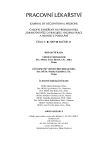Working positions – experience from the practice of physiological measurements
Authors:
V. Straková; H. Lehocká; Ž. Hudeczková; G. Zdařilová; M. Sikorová; A. Fojtík; E. Mitrengová; T. Illéš; V. Kilián
Authors‘ workplace:
Zdravotní ústav se sídlem v Ostravě, ředitel RNDr. Petr Hapala, Oddělení fyziologie a psychologie práce, vedoucí oddělení MUDr. Hana Lehocká, Ph. D.
Published in:
Pracov. Lék., 61, 2009, No. 4, s. 157-163.
Category:
Original Papers
Overview
Authors present documentation on working positions of the head, neck, trunk, upper and lower extremities using videorecords taken during preventive examinations.Unfavourable working positions are demonstrated in relation to legislation and the significance of the time record is highlighted. Deeper proflexion of head and neck with partial support of trunk or without support were found, more frequently of a static nature, less frequently repeated lateral extension. Moderate or deeper proflexion of the trunk was repeatedly found with marginal or moderately prevailing static load. Elevation in shoulder joints, respectively maximal extension in elbow joints in relation to an inadequate manipulation level were the most frequent unfavourable positions of upper extremities. The static load was prevailing. Nonphysiological positions of wrist (repeated torsion, dorsal and ventral flexion) were found less frequently. As concerns lower extremities, working on knees was associated with a sharp angle in a knee joint, most frequently with the support of buttocks by heels in order to fix the trunk and upper extremities during manual manipulations. Compensatory measures are predominantly connected with investments (correction of manipulation levels, breaks related to decrease of norms, changing workers). In order to minimize costs from the part of the employer, legislative measures are fullfiled in relation to employment of workers physically and habitually disposed for given working conditions, which are considered discrimination measures in relation to age, height and physical condition.
Key words:
protection of public health, working positions, measures lowering health risk, occupational diseases in relation to working positions
Sources
1. Gilbertová S., Matoušek O. Ergonomie. Optimalizace lidské činnosti. Praha: Grada 2002, 240 s.
2. Nařízení vlády č. 361/2007 Sb., kterým se stanoví podmínky ochrany zdraví při práci.
3. Vyhláška č. 432/2003 Sb., kterou se stanoví podmínky pro zařazování prací do kategorií, limitní hodnoty ukazatelů biologických expozičních testů, podmínky odběru biologického materiálu pro provádění biologických expozičních testů a náležitosti hlášení prací s azbestem a biologickými činiteli.
4. Zákon č. 258/2000 Sb., o ochraně veřejného zdraví, a o změně některých souvisejících zákonů v platném znění.
Labels
Hygiene and epidemiology Hyperbaric medicine Occupational medicineArticle was published in
Occupational Medicine

2009 Issue 4
Most read in this issue
- Risk factors at work in the bakery
- Working positions – experience from the practice of physiological measurements
- Noise as a risk factor in school facilities
- Significance of measuring skin temperatures in diagnostics of the Raynaud syndrome from vibrations
